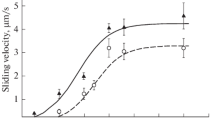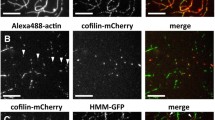Summary
The effect of smooth muscle myosin at different levels of light chain phosphorylation on caldesmon-mediated movement of actin filaments was investigated using an in vitro motility assay. Myosin at different levels of phosphorylation was obtained by mixing different proportions of fully phosphorylated and unphosphorylated myosin in monomeric form, while keeping the total myosin concentration constant. The average velocity of actin filaments containing tropomyosin was 1.20±0.046 μm s−1 at 30°C with fully phosphorylated myosin. This velocity was not altered when the percentage of unphosphorylated myosin coated on the nitrocellulose surface was increased to 80%; further increases lowered the velocity. When the actin filaments with caldesmon bound at stoichiometric levels were used, filament velocity was unaffected until 50% of the myosin was unphosphorylated, but further increases in the percentage of unphosphorylated myosin induced a decrease in the velocity, and at 95% unphosphorylated myosin, filament movement had ceased. The decreased filament velocity in the presence of caldesmon was also observed when phosphorylated myosin was mixed with myosin rod instead of unphosphorylated myosin, but was not observed when the 38 kDa caldesmon C-terminal fragment, which lacks the myosin-binding domain, was used instead of intact caldesmon. These data indicate that the decreased filament velocity in the presence of caldesmon reflects the mechanical load produced by the tethering of actin to myosin through the interaction of the caldesmon N-terminal domain and the myosin S-2 region. The tethering effect mediated by caldesmon may play a role in smooth muscle contraction when a large number of myosin heads are dephosphorylated, as in force maintenance.
Similar content being viewed by others
References
ARNER, A. & HELLSTRAND, P. (1985) Effects of calcium and substrate on force-velocity relation and energy turn-over in skinned smooth muscle of the guinea-pig. J. Physiol. 360, 347–65.
BUTLER, T. M., SIEGMAN, M. J. & MOOERS, S. U. (1983) Chemical energy usage during shortening and work production in mammalian smooth muscle. Am. J. Physiol., 244, C234–42.
CHACKO, S. (1981) Effect of phosphorylation, calcium ion, and tropomyosin on actin activated adenosine 5′-triphosphatase activity of mammalian smooth muscle myosin. Biochem 20, 702–7.
DABROWSKA, R., GOCH, A., GALAZKIEWICZ, B. & OSINSKA, H. (1985) The influence of caldesmon on ATPase activity of the skeletal muscle actomyosin and bundling of actin filaments. Biochim. Biophys. Acta 842, 70–5.
DILLON, P. F., AKSOY, M. O., DRISKA, S. P. & MURPHY, R. A. (1981) Myosin phosphorylation and cross-bridge cycle in arterial smooth muscle. Science 211, 495–7.
DOBROWOLSKI, Z., BOROVIKO, Y. S., NOWAK, E., GALAZKIEWICZ, B. & DABROWSKA, R. (1988) Comparison of Ca2+-dependent effects of caldesmon-tropomyosin-calmodulin and troponin-tropomyosin complexes on the structure of F-actin in ghost fibers and its interaction with myosin heads. Biochim. Biophys. Acta 956, 140–50.
FUJII, T., IMAI, M., ROSENFELD, G. C. & BRYAN, J. (1987) Domain mapping of chicken gizzard caldesmon. J. Biol. Chem. 262, 2757–63.
HAEBERLE, J. R., TRYBUS, K. M., HEMRIC, M. E. & WARSHAW, D. M. (1992) The effects of smooth muscle caldesmon on actin filament motility. J. Biol. Chem. 267, 23001–6.
HAI, C. M. & MURPHY, R. A. (1989) Ca2+ crossbridge phosphorylation and contraction. Ann. Rev. Physiol. 51, 285–98.
HARRIS, D. E., WORK, S. S., WRIGHT, R. K., ALPERT, N. R. & WARSHAW, D. M. (1994) Smooth, cardiac and skeletal muscle myosin force and motion generation assessed by cross-bridge mechanical interactions in vitro. J. Muscle Res. Cell Motil. 15, 11–19.
HEMRIC, M. E. & CHALOVICH, J. M. (1988) Effect of caldesmon on the ATPase activity and the binding of smooth and skeletal myosin subfragments to actin. J. Biol. Chem. 263, 1878–85.
HORIUCHI, K. Y. & CHACKO, S. (1988) Interaction between caldesmon and tropomyosin in the presence and absence of smooth muscle actin. Biochem 27, 8388–93.
HORIUCHI, K. Y. & CHACKO, S. (1989) Caldesmon inhibits the cooperative turning-on of the smooth muscle heavy meromyosin by tropomyosin-actin. Biochem. 28, 9111–16.
HORIUCHI, K. Y. & CHACKO, S. (1993) The effect of caldesmon on myosin-actin interaction is mediated through tropomyosin. Biophys. J. 64, A34.
HORIUCHI, K. Y. & CHACKO, S. (1994) Regulation of actin filament velocity by caldesmon: the effect of unphosphorylated myosin. Biophys. J. 66, A140.
HORIUCHI, K. Y., MIYATA, H. & CHACKO, S. (1986) Modulation of smooth muscle actomyosin ATPase by thin filament associated proteins. Biochem. Biophys. Res. Commun. 136, 962–8.
HORIUCHI, K. Y., SAMUEL, M. & CHACKO, S. (1991) Mechanism for the inhibition of acto-heavy meromyosin ATPase by the actin/calmodulin binding domain of caldesmon. Biochem 30, 712–17.
IKEBE, M. & REARDON, S. (1988) Binding of caldesmon to smooth muscle myosin. J. Biol. Chem. 263, 3055–8.
KAMM, K. E. & STULL, J. T. (1985) The function of myosin and myosin light chain kinase phosphorylation in smooth muscle. Ann. Rev. Pharmacol. Toxicol. 25, 593–620.
KISHINO, A. & YANAGIDA, T. (1988) Force measurements by micromanipulation of a single actin filament by glass needles. Nature 334, 74–6.
KRON, S. J. & SPUDICH, J. A. (1986) Fluorescent actin filaments move on myosin fixed to a glass surface. Proc. Natl Acad. Sci. USA 83, 6272–6.
LAEMMLI, U. K. (1970) Cleavage of structural proteins during the assembly of the head of bacteriophage T4. Nature 277, 680–5.
LOWRY, O. H., ROSENBROUGH, N. J., FARR, A. L. & RANDALL, R. J. (1951) Protein measurement with the folin phenol reagent. J. Biol. Chem. 193, 265–75.
MARGOSSIAN, S. S. & LOWEY, S. (1982) Preparation of myosin and its subfragments from rabbit skeletal muscle. Methods Enzymol. 85, 55–71.
MARSTON, S. B. (1990) Stoichiometry and stability of caldesmon in native thin filaments from sheep aorta smooth muscle. Biochem. J. 272, 305–10.
MARSTON, S. B., PINTER, K. & BENNET, P. (1992) Caldesmon binds to smooth muscle myosin and myosin rod and crosslinks thick filaments to actin filaments. J. Muscle Res. Cell Motil. 13, 206–18.
MARSTON, S. B., LEHMAN, W., WOODY, C. J. & SMITH, C. W. J. (1985) Ca2+ dependent regulation of smooth muscle thin filaments by caldesmon. In Advances in Protein Phosphatases II (edited by MERLEVEDE, W., LENS, H. & DISALVO, J.) pp. 171–89. Leuven: Leuven University Press.
MERKEL, L., GERTHOFFER, W. T. & TROPHY, T. (1990) Dissociation between myosin phosphorylation and shortening velocity in canine trachea. Am. J. Physiol. 258, C524–32.
MURPHY, R. A. (1989) Contraction in smooth muscle cells. Ann. Rev. Physiol. 51, 275–83.
OKAGAKI, T., HIGASHI-FUJIME, S., ISHIKAWA, R., TAKANO-OHMURO, H. & KOHAMA, K. (1991) In vitro movement of actin filaments on gizzard smooth muscle myosin: requirement of phosphorylation of myosin light chain and effects of tropomyosin and caldesmon. J. Biochem. 109, 858–66.
PARDEE, J. D. & SPUDICH, J. A. (1982) Purification of muscle actin. Methods Enzymol. 85, 164–81.
PERRIE, W. T. & PERRY, S. V. (1970) An electrophoretic study of the low-molecular-weight components of myosin. Biochem. J. 119, 31–8.
SHIRINSKY, V. P., BIRYUKOV, K. G., HETTASCH, J. M. & SELLERS, J. R. (1992) Inhibition of the relative movement of actin and myosin by caldesmon and calponin. J. Biol. Chem. 267, 15886–92.
SMITH, C. W. J., PRITCHARD, K. & MARSTON, S. (1987) The mechanism of Ca2+ regulation of vascular smooth muscle thin filaments by caldesmon and calmodulin. J. Biol. Chem. 262, 116–22.
SOBUE, K., TAKAHASHI, K. & WAKABAYASHI, I. (1985) Caldesmon150 regulates the tropomyosin-enhanced actin-myosin interaction in gizzard smooth muscle. Biochem. Biophys. Res. Commun. 132, 645–51.
SOBUE, K., MURAMOTO, Y., FUJITA, M. & KAKIUCHI, S. (1981) Purification of a calmodulin-binding protein from chicken gizzard that interacts with F-actin. Proc. Natl Acad. Sci. USA 78, 5652–5.
SUTHERLAND, C. & WALSH, M. P. (1989) Phosphorylation of caldesmon prevents its interaction with smooth muscle myosin. J. Biol. Chem. 264, 578–83.
SZPACENKO, A. & DABROWSKA, R. (1986) Functional domain of caldesmon. FEBS Letts 202, 182–6.
TRYBUS, K. M. & LOWEY, S. (1984) Conformational states of smooth muscle myosin: effects of light chain phosphorylation and ionic strength. J. Biol. Chem. 259, 8564–71.
UYEDA, T. Q. P., KRON, S. J. & SPUDICH, J. A. (1990) Myosin step size estimation from slow sliding movement of actin over low densities of heavy meromyosin. J. Mol. Biol. 214, 699–710.
VELAZ, L., INGRAHAM, R. H. & CHALOVICH, J. M. (1990) Dissociation of the effect of caldesmon on the ATPase activity and on the binding of smooth heavy meromyosin to actin by partial digestion of caldesmon. J. Biol. Chem. 265, 2929–43.
VELAZ, L., HEMRIC, M. E., BENSON, C. E. & CHALOVICH, J. M. (1989) The binding of caldesmon to actin and its effect on the ATPase activity of soluble myosin subfragments in the presence and absence of tropomyosin. J. Biol. Chem. 264, 9602–10.
VYAS, T. B., MOOERS, S. U., NARAYAN, S. R., WITHERBELL, J. C., SIEGMAN, M. J. & BUTLER, T. M. (1992) Cooperative activation of myosin by light chain phosphorylation in permeabilized smooth muscle. Am. J. Physiol. 263, C210–19.
WARSHAW, D. M., DESROSIERS, J. M., WORK, S. & TRYBUS, K. M. (1990) Smooth muscle myosin cross-bridge interactions modulate actin filament sliding velocity in vitro. J. Cell Biol. 111, 453–63.
WASHABAU, R. J., WANG, M. B. & RYAN, J. P. (1991) Myosin light chain phosphorylation and contraction of guinea pig gallbladder smooth muscle. Am. J. Physiol. 261, G952–7.
Author information
Authors and Affiliations
Rights and permissions
About this article
Cite this article
Horiuchi, K.Y., Chacko, S. Effect of unphosphorylated smooth muscle myosin on caldesmon-mediated regulation of actin filament velocity. J Muscle Res Cell Motil 16, 11–19 (1995). https://doi.org/10.1007/BF00125306
Received:
Revised:
Accepted:
Issue Date:
DOI: https://doi.org/10.1007/BF00125306




